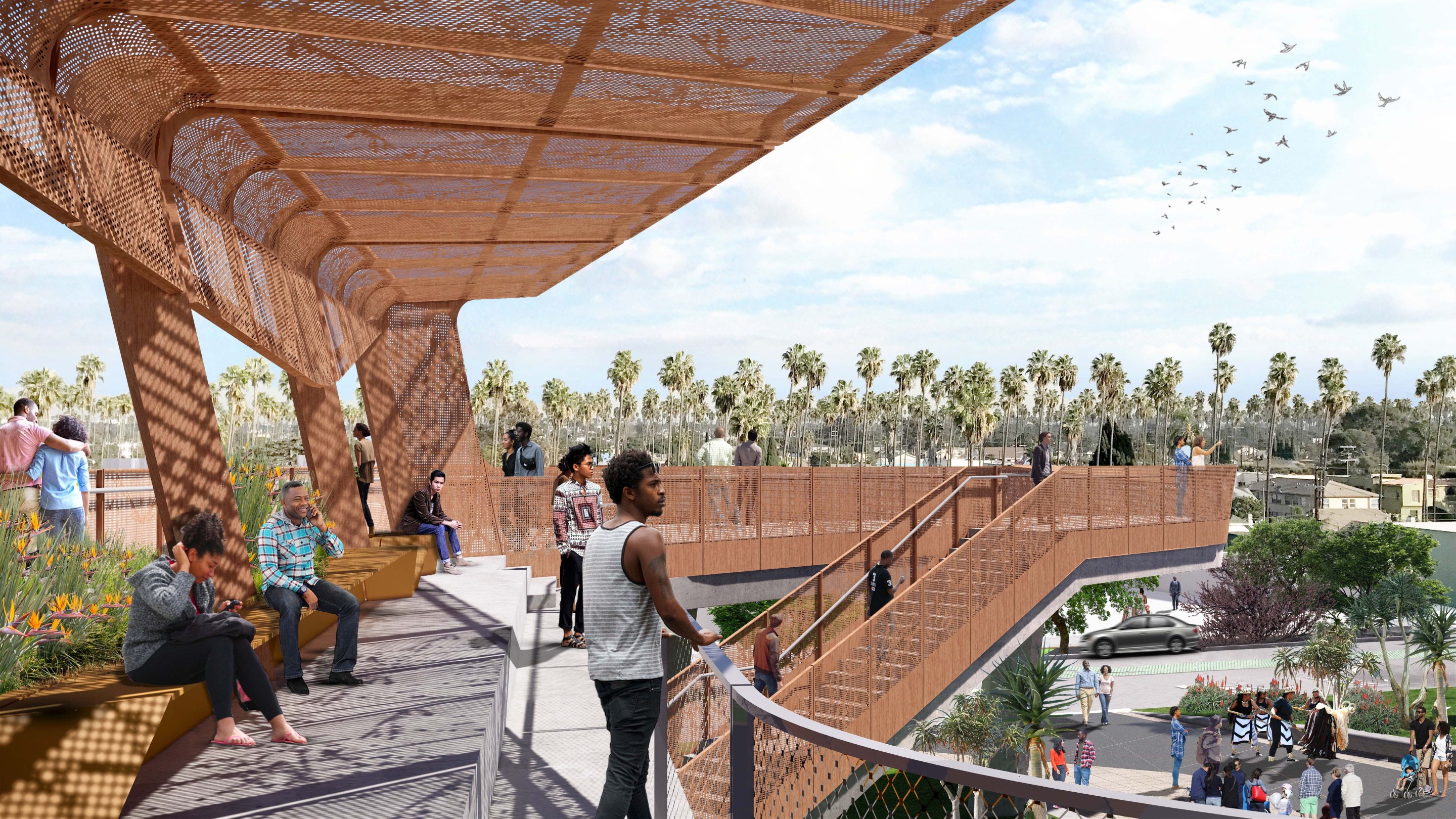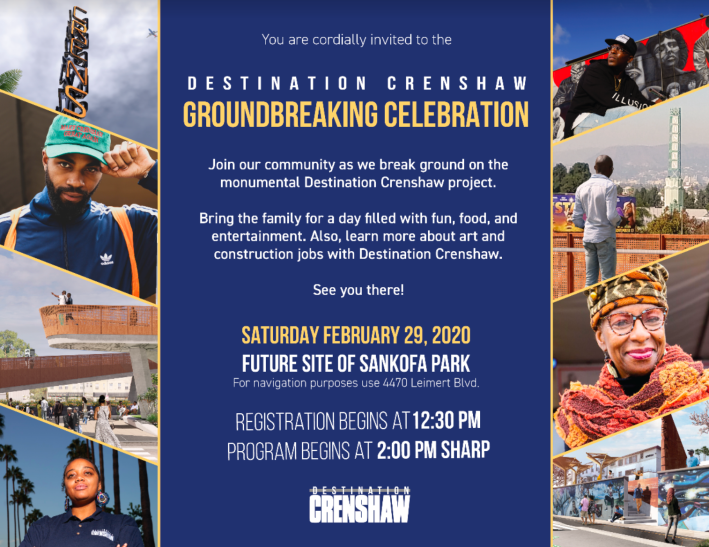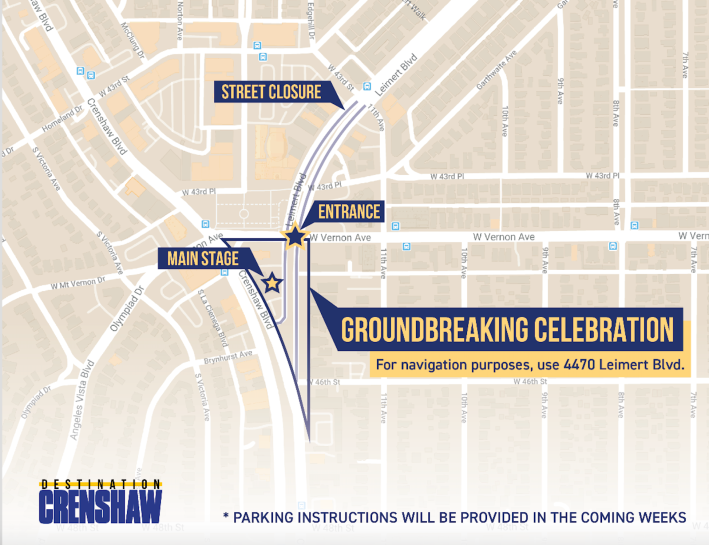On February 29, as Black History Month comes to a close, community leaders will gather at Vernon and Crenshaw to break ground on Destination Crenshaw - the 1.3-mile-long public art project featuring a mix of permanent and rotating art works that will celebrate Black life, culture, and contributions year 'round.

As we first wrote last year, the project was inspired by the desire to "turn insult into opportunity" and guard against the erasure of the community from its own streets.
When Metro laid out its plans to save on construction costs by running the Crenshaw/LAX Line at-grade up the spine of the Black community a decade ago, many had feared it could jeopardize the survival of the last remaining Black-owned business corridor in the city. The fact that Metro had originally planned to bypass Leimert Park Village – the cultural beating heart of the Black community – added to the sense that Metro's leadership fell somewhere between being indifferent to the community’s value and openly hostile to it.
The community eventually prevailed, getting Metro to agree to a Leimert Park station at 43rd Place (although the train would still run at-grade).
Then the real work began.
To harness the change the train was sure to bring, Leimert Park Village stakeholders launched the 20/20 Vision Initative in 2014 - their effort to brand the village as a hub for Black creatives and safeguard it as a site of celebration of the diaspora.
Two years later, Eighth District councilmember Marqueece Harris-Dawson embarked on a series of conversations with community members about the future of Crenshaw. The goal was to build a vision for how to permanently stamp the “capital of Black life,” as Harris-Dawson has called it, as an unapologetically Black space.
![Nipsey Hussle (at center) and Councilmember Marqueece Harris-Dawson (at right) meet with students to talk Destination Crenshaw and the future of the community. [Click image to visit the original Instagram post]](https://lede-admin.la.streetsblog.org/wp-content/uploads/sites/50/2018/12/Screen-Shot-2018-12-13-at-4.44.29-PM.png?w=710)
Over the course of the next year and a half, the community advisory council and a team of architects from Perkins+Will settled on an overarching theme for the project: Grow Where You Are Planted. Taking inspiration from the community's resilience in the face of “root shock,” the theme allows for exploration of the different threads shaping the community's past, present, and future.
Four nodes will anchor key elements of the community's journey. In a nod to the late rapper, entrepreneur, and visionary Nipsey Hussle, the "Improvisation" node (at Slauson) will speak to the community’s resourcefulness and capacity to transform adversity into opportunity. At 54th Street, “Firsts” will trace through-lines from Biddy Mason (who petitioned for her freedom in 1856, became one of the first Black women to own land in L.A., and was a founding member of the First AME Church) to present-day pioneers in the arts, entrepreneurship, and activism. "Dreams," at 50th, takes inspiration from architect Paul Revere Williams and will speak to the community's unique capacity to push beyond established boundaries and create space for itself. Finally, at Vernon, “Togetherness” will illuminate the vibrant cultural infrastructure Leimert Park Village has carefully nurtured over the years – one that draws on the wisdom of the ancestors and leads with unity.

Eleven pocket parks distributed among the nodes, each with their own permanent artwork, will create opportunities for deeper engagement with the specific themes. The parks will also vary in size and function, with some being able to support larger gatherings or performances and others being better suited for play or quiet contemplation.
Rotating exhibitions along the corridor featuring artworks from local artists will underscore the fact that “there is not one Black L.A. story,” as advisory council member Tafarai Bayne, explained at the King Day celebration last year.
“A lot of this project is about creating programmable space where the Blackness can be layered on in a contemporary way that represents what Blackness is now. Or tomorrow. Or 100 years from now,” Bayne continued. “We’re setting the stage for Black people to take it into the future...[while] honor[ing] what Blackness has always been: adaptable to the world; changing; self-determining; and [transcending] the conditions we’ve had to deal with over and over.”
Some in the community have challenged the idea that the project will protect the community from erasure, arguing instead that the creation of a cultural attraction will just hasten their displacement.
Last November, the Crenshaw Subway Coalition issued a statement contending that, "The unfortunate history of massive outdoor art projects like this, as perhaps most well illustrated with the High Line in New York City, is that they end up fueling the housing price increases that push out and price out the residents of color that they say they're going to serve." Would it not be better to use the $100 million the project is estimated to cost to purchase properties along the boulevard and put them in a community land trust, securing a Black presence forever?
When confronted with a similar line of questioning in an interview in July of 2018, Harris-Dawson acknowledged investment can be a double-edged sword. He also made the case that part of the work of helping a community remain in place included the neighborhood first being clearly identifiable as a Black space.
The fact that Crenshaw had not been valued in that way outside the community was something he had underscored in his original pitch to the community. "This is not something they ask you to do…or invite you in the room [for],” he had told stakeholders gathered at the Museum of African American Art (MAAA) for the project's first public unveiling back in March of 2018. “This is something we have to assert [ourselves]."
And it's something that advisory council members have said guided their thinking throughout the planning process.
"Are we making this for other folks to move in? No," said artist, designer, and self-described Gangsta Gardner Ron Finley at a preview of the project in December of 2018.
Instead, the goal was to “lead with culture” and communicate to community members that the project was, first and foremost, for them. That the corridor would not just be a place to celebrate unapologetically Black contributions, but also a place where it was safe to be unapologetically Black in Public - a Black Space, full stop.
Still, the groundbreaking comes at a moment of significant change along the corridor. The pending arrival of the Crenshaw Line - set to open later this year - has fueled speculation and turnover up and down the boulevard. Most notable among the pending changes are the plans of billionaire Jeff Greene to replace 206 rent-controlled units at Dorset Village with 782 units of mostly market-rate housing. The displacement of 163 lower-income Black and brown families just east of Nipsey Hussle Square (at Crenshaw and Slauson) stands in direct contrast to the ground-up work Hussle had done - and that his partners have vowed to continue to do - on that corner to build a foundation from which his community could rise together.
We'll have more on Destination Crenshaw as the groundbreaking approaches. For now, to RSVP for the event, please visit the Destination Crenshaw website.
For more background on the project, please see our in-depth story below, as well as coverage of the passing of Nipsey Hussle, the demolition of Dorset Village, and other corridor happenings.
- Destination Crenshaw
- Nipsey Hussle
- August, 2019: Nipsey Hussle Understood Cities Better than You. Why Didn’t You Know Who He Was?
- August, 2019: City Attorney Keeps up Pressure to Evict Nipsey Hussle’s Legacy from Crenshaw and Slauson
- April, 2019: South Central Gives Nipsey Hussle the Send-Off of a Lifetime (photo essay)
- September, 2019: L.A. Podcast Segment Begins Unpacking Nipsey Hussle’s Legacy with Chavonne Taylor, Tafarai Bayne, and Streetsblog L.A.’s Sahra Sulaiman
- Dorset Village
- Expo/Crenshaw
- Leimert Park
- June, 2017: Ancestors v. Polka Dots: Some Thoughts on Approaches to “Place-Making”
- April, 2017: Leimert Park Envisions Infusing Culture into Autonomous Micro Shuttles
- January, 2017: Leimert Park Village Hosts Third Design Charrette
- July, 2015: Leimert Park People St Plaza Opens; Stakeholders Debate Building a Cultural Center
- October, 2014: Leimert Park People St Plaza: Making a Cookie-Cutter Program Fit a Cultural Community’s Aspirations
- January, 2014: So, Ground Has Officially Been Broken for the Crenshaw Line. What Does That Mean for People in the Area?
- December, 2013: Fighting Gentrification with Sankofa Red - a Repurposed Pay Phone
- April, 2013: Ring, Ring! Who’s There? The Leimert Phone Company!
- June, 2012: What You Wish You Hadn’t Missed this Weekend: Art, Community, Masks, and Ancestors in Leimert Park
- Baldwin Hills Crenshaw Plaza
- Black Kids on Bikes (BKoB) and Ride On! Bike Co-op
- January, 2019: Community Service Comes Full Circle for Members of Black Kids on Bikes at King Day Parade
- July, 2015: Open-Air Bike Tune-Up Session Brings Community Together in Leimert Park
- January, 2015: Are You Supposed to Be Here?: Officer Harasses Black Cyclists During MLK Day Parade
- January, 2013: Black Kids on Bikes Spread the Gospel of the Bike at the King Day Parade
- Space Shuttle Endeavour
- October, 2012: Late to Its Own Party, Endeavour At Least Has Decency to Put On a Good Show (photo essay)
- September, 2012: Science Center Given Approval to Remove Nearly 400 Trees to Make Way for Shuttle
- September, 2012: Endeavouring to Find Opportunities for Communities in the Wake of the Shuttle’s Passage









